Day 2 ( Feb 4th)
Click here for day 1
Scheduled to visit Nathu-La Pass and Tsomgo Lake.
Our travel agent generously provided us with a pair of genuine mountaineer’s jackets, and though we looked a bit like puffed-up marshmallows in those jackets along with our gloves and caps from home, we were perfectly warm inside.
We were picked up from our hotel by a Maruti car and taken to the JN Road Taxi Centre—well past the planned 7 AM departure time. Every morning, numerous vehicles depart from this point to Nathula Pass. The taxi center is quite an impressive structure, with three floors dedicated to parking vehicles. Most of the vehicles making this journey are Tata Spacios, each with a capacity for the driver and nine passengers, making it ten people in total. It’s definitely a tight squeeze, but the collective warmth of ten bodies certainly makes up for the discomfort.
The journey to Nathula Pass isn’t exactly a smooth ride, and everything hinges on the driver. A poor driver can make the trip unbearable, but we were lucky—our driver handled the vehicle skillfully and smoothly, quite unlike the driver we had from Bagdogra to Gangtok. In a mountainous state like Sikkim, driving skills are critical, whether for safety or simply for the comfort of the passengers.
Visiting Nathula Pass requires prior permission since it takes you very close to the Chinese border. You’ll need to submit proof of identity, such as a photocopy of your passport or voter ID along with a photo. I had sent our passport copies and scanned photos to our travel agent a week in advance, so we had no issues getting permission—thanks to our reliable travel agent. However, some tourists were not as fortunate, missing the trip due to missing documents or photos. If you’re planning to visit Nathula Pass, be prepared! After all, what’s a trip to Sikkim without experiencing Nathula Pass?
We finally left the taxi stand around 8:30 AM, and after about an hour of driving, we made our first stop at the 15th Mile Police Picket. This small checkpoint has a few tea stalls that serve as a popular pit stop for most travelers heading up the mountain. At an altitude of about 10,400 feet, the air is brisk and chilly—perfect for a warm cup of tea. It’s also worth noting that the thinner air at this height might cause some discomfort for the elderly or anyone unaccustomed to the altitude. From here, Tsomgo Lake is just 8 kilometers away, while Nathula Pass lies about 25 kilometers further along the winding road.
There are a few shops here selling fast and junk food, along with a handful of houses scattered around. We saw children sitting outside with pickle bottles, trying to soak up whatever warmth they could from the sun. This spot also serves as an access point to the Kyongnosla Alpine Sanctuary, which we weren’t scheduled to visit. However, it’s said to be an interesting place, especially for those with an interest in studying the region’s unique flora.
After about an hour and a half of driving from the 15th Mile Police Picket, we finally reached Nathula Pass. Along the way, the landscapes gradually transformed, with patches of snow dusting the mountainsides. It was our first time seeing snow, and it was truly exhilarating. On the journey, we also passed the renowned Tsomgo Lake, though we didn’t stop then. It was a sight we were excited to explore on our way back.
We finally arrived at Nathula Pass. Stepping out of the vehicle, we were met with a wave of dizziness—it took a moment to adapt to the thin air and the altitude. Many around us found it difficult to climb even a few steps, and it wasn’t hard to see why. The temperature hovered around -4°C, and a biting wind blew directly into our faces. Our ears and fingers quickly became numb, a mild but constant pain reminding us of the raw power of the elements.
But despite the cold, the view was absolutely awe-inspiring. We were standing at the literal border between India and China—a surreal experience that brought a mix of fear and exhilaration. Standing here, surrounded by nothing but snow and mountains, we couldn’t help but be overwhelmed by the sheer bravery of the Indian Army.
These soldiers endure the toughest of conditions—biting cold, thin air, and isolation that most of us could hardly imagine. Yet, they remain steadfast and resolute, day in and day out, with a spirit of service that commands respect. They stay here, miles away from their families, so that we can live in peace with our loved ones. Their courage is not just about facing the cold but also about facing uncertainty every single day. The tricolor fluttering proudly here is a testament to their unyielding spirit, and seeing them guard this remote and rugged border fills you with immense pride.
The soldiers greeted us with warmth despite the freezing temperatures, their smiles a reminder of their dedication and resilience. Their presence here, in such hostile terrain, makes us realize that our peaceful lives are secured by their sacrifices. We owe them a debt of gratitude—not just for guarding our borders but for the countless sacrifices they make without expecting anything in return. To say that they are the true heroes of our nation would be an understatement; they embody bravery, selflessness, and patriotism at its finest. Standing at Nathula Pass, face to face with these incredible men, we felt nothing but respect, pride, and deep, heartfelt gratitude for the Indian Army.
The Soldier Memorial at Nathula Pass is a truly sacred place. Jahnavi and I stood there for a long time without speaking, yet completely understanding each other’s thoughts. This memorial represents the sacrifices of soldiers who gave their lives for us, for our freedom, and for our peaceful existence. They are like our fathers and mothers—selflessly protecting us, even at the cost of their own lives. Jahnavi wanted to find flowers to lay at the memorial, but unfortunately, we couldn’t find any. Even if we had, security restrictions wouldn’t have allowed us to lay them ourselves. Instead, we offered our silent, heartfelt respects to the soldiers who laid down their lives for the protection of our nation.
Standing there, I remembered my Surgery professor from my fourth-year clinicals. He taught us not only clinical methods and surgery but also the importance of values beyond medicine. One day, after we had spent about an hour examining a soldier who came in with a lump in his abdomen, the professor gave us a lesson I never forgot: “Never charge a soldier when they walk into your clinic or hospital.” And I have lived by that rule ever since.
Two years ago, a soldier came to me, bringing his wife for a tubectomy reversal. I performed the surgery without charging them a fee. A year later, that proud soldier returned with a gift, joyfully announcing the birth of their new child. He brought me an army ration whiskey bottle as a token of gratitude. That bottle wasn’t just a gift—it was a symbol of the resilience, sacrifice, and indomitable spirit of our soldiers, and the gratitude they carry. Moments like these remind us why our respect for the Indian Army runs so deep—they are the true protectors of our nation, deserving of every ounce of admiration we can give.
At Nathula Pass, the grandeur of two nations—India and China—boils down to just two buildings, separated by only a few feet of land. In the picture to the left, you can see both buildings. The Chinese building prominently displays a red star on its frontage. During our visit, we didn’t get the chance to see any Chinese soldiers up close. However, the Indian soldiers stationed there shared stories of how they frequently encounter Chinese soldiers face to face, sometimes exchanging a word or two—perhaps a cautious greeting now and then.
On the Indian side, there’s even a board displaying common Chinese phrases like “Good Morning” and “How are you?”—a small yet thoughtful gesture aimed at breaking the ice across this tightly guarded border. Had we seen any soldiers there that day, we would have greeted them, no matter how brief or simple the interaction might have been. It was intriguing to think that, despite all the political tension and the heavy military presence, humanity finds its way through simple words exchanged across an international line.
At an altitude of 14,200 feet, there’s a canteen and an STD booth—a surprising yet very welcome sight at such an elevation. It’s one of the few comforts available at this height, and it’s impeccably maintained by the army personnel. The canteen is sparkling clean, offering a place to warm up and grab a quick snack. The STD booth, also run by the army, allows you to call your loved ones and preserve the receipt as a unique memento—a record of a phone call made from 14,200 feet above sea level! For an extra bit of nostalgia, you can even buy a certificate for ?50 that proudly declares your visit to Nathula Pass. It’s small touches like these that make the experience all the more memorable.
Our army stands resolute, guarding us tirelessly, and at Nathula Pass, it was the Bihar Regiment keeping watch. We had the honor of meeting Mr. Ojha, who was on duty, and after seeking his permission, we clicked this photograph. It’s impossible not to admire these heroes who protect our borders, standing strong in the harshest conditions. Incidentally, Mr. Ojha also sports a fantastic mustache—an impressive style that adds to his already admirable presence. These brave men are the real embodiment of courage, and moments like this make us truly appreciate their dedication.
The canteen at this altitude is simply immaculate. The table tops and counters are spotless, every inch shining with care and attention. There are a few cheerful young women from the local families assisting at the counter, adding a personal and welcoming touch to the experience. The food on offer—freshly baked bread and hot samosas—is fantastic, served piping hot and at very nominal prices. The combination of a clean environment, a warm room, and delicious hot food served by smiling faces makes it easy to lose track of time. It’s the kind of place where you want to linger a little longer—certainly more time than our driver’s patience could allow as he waited for us to come back!
Known as the “Hero of Nathula,” the Baba Harbhajan Singh Temple stands as a tribute to a former soldier revered for his dedication and sacrifice. Located at an altitude of 12,651 feet, the temple is positioned at the intersection of Nathula and Jelep La, attracting visitors who come to honor his legacy. The story of Baba Harbhajan Singh is one of courage and legend, and his spirit is believed to continue guarding the soldiers stationed in these rugged, high-altitude terrains. The temple is more than just a shrine; it represents the valor and devotion of those who serve at our borders.
Frozen water
Tsomgo Lake is a serene and picturesque gem nestled in the Himalayas, near Nathula Pass on the Indo-China border. Perched at an elevation of 4,342 meters (14,248 feet), the lake is surrounded by towering mountains and lush green forests, making it a breathtaking sight. It’s a popular destination for trekkers, offering spectacular views of the surrounding Himalayan ranges. During the trek to Tsomgo Lake, tourists are rewarded with stunning vistas, including glimpses of the majestic Kanchenjunga range. The trek is of medium difficulty, making it accessible for adventure-seekers of all experience levels. With its serene waters reflecting the beauty of the Himalayas, Tsomgo Lake truly feels like a slice of paradise amidst the rugged mountains.


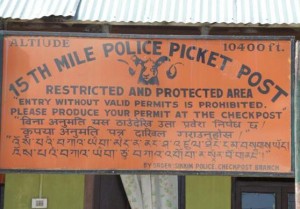
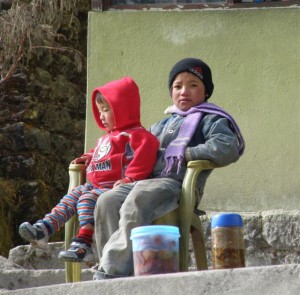
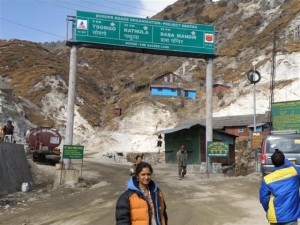


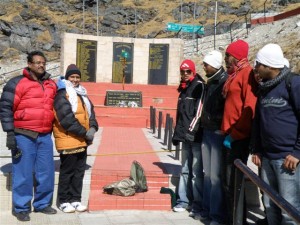
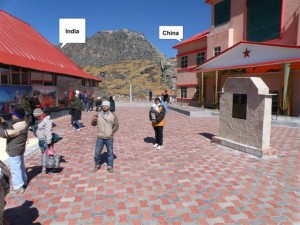

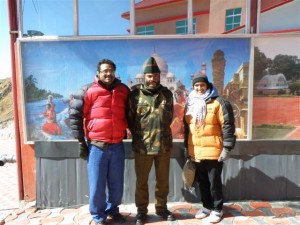
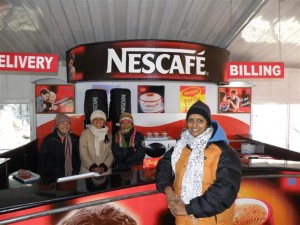
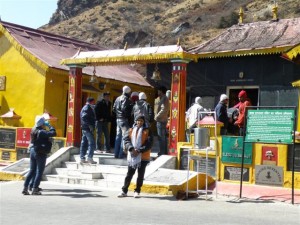
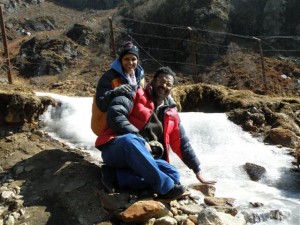
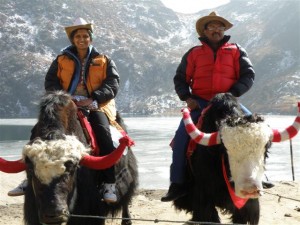
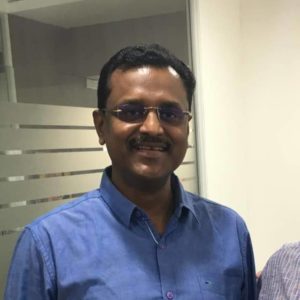
Thanks for Sharing such a nice article. 🙂
Sir ,I plan to visit nathula pass on 17.05.2013. your article help me so much
Appreciate ur writeup. It would be really helpful to seniors like us, specially briefing about weather condition. Shocked to see the chinese border so close, never imagined. Over all a very good informative travelogue
very, nice informative, with much essay writing, thank you, for making me realise to manintain my blog too, which i will do in future, cheers.
super information, thank you